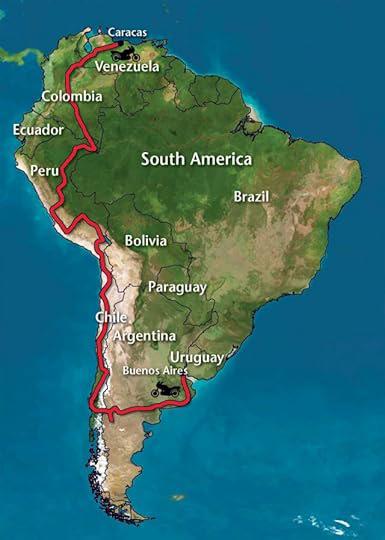Map of Che Guevara's Motorcycle Diaries Journey


Alex Cartwright
Senior Cartographer & GIS Specialist
Alex Cartwright is a renowned cartographer and geographic information systems specialist with over 15 years of experience in spatial analysis and data...
Geographic Analysis
What This Map Shows
The map titled "The Motorcycle Diaries: Latin American Journey Ernesto Che Guevara, Aleida Guevara" visualizes the route taken by the iconic revolutionary figure Ernesto Che Guevara and his companion Aleida Guevara during their transformative journey across Latin America in the early 1950s. This journey, documented in Che's famous memoir, encapsulates not just the physical distance traveled but also the profound social and political landscapes they encountered. From the lush jungles of Argentina to the rugged mountains of Bolivia, the map highlights key locations, routes, and experiences that were pivotal in shaping Guevara's revolutionary ideology.
Deep Dive into the Journey of Che Guevara
Che Guevara's journey across Latin America was not merely a road trip; it was a quest for understanding and discovery. Beginning in 1951, Guevara and his friend Alberto Granado embarked on a journey on a 1939 Norton motorcycle, affectionately named "La Poderosa" (The Powerful One). This journey took them through diverse landscapes, including the Andes mountains, the Amazon rainforest, and the arid Atacama Desert, providing Che with firsthand experiences of the socio-economic struggles faced by the people.
Interestingly, Che's observations during this trip were crucial in shaping his views on imperialism, capitalism, and the plight of the marginalized. For instance, as they traveled through Peru, they encountered indigenous communities who were struggling against poverty and oppression. This experience significantly influenced Guevara's later commitment to revolutionary change, as he recognized the interconnectedness of social injustice and economic disparity.
Throughout the journey, which covered over 8,000 kilometers, Che documented various locations that would later become symbolic in revolutionary history. In Chile, for example, they visited the mining town of Chuquicamata, which highlighted the exploitation of workers and the impact of foreign corporations on local economies. Each stop on their route was not just a dot on the map but a narrative of the challenges faced by the people they met.
Moreover, Guevara's experience with leprosy patients in a clinic in San Pablo, Peru, deepened his empathy and understanding of human suffering, further motivating his desire for social reform. The physical and emotional toll of this journey laid the groundwork for his later actions as a revolutionary leader in Cuba and beyond.
Regional Analysis
The journey encompassed several key regions, each with its unique characteristics and historical contexts. In Argentina, Che's home country, the landscape is marked by a mix of urban and rural settings. Here, he was able to reflect on his own upbringing and the socio-political dynamics that influenced his worldview. The map shows cities like Buenos Aires, where economic disparities were starkly visible, providing a backdrop for his formative experiences.
Moving into Bolivia, the map reveals a shift in both terrain and culture. The highlands present rugged landscapes that symbolize the resistance of indigenous populations against colonial powers. Guevara's interactions here were pivotal, as he encountered communities rich in history yet economically marginalized. This region would later play a significant role in Guevara's revolutionary activities, culminating in his guerrilla warfare efforts aimed at liberating oppressed peoples.
Chile, too, stands out on the map, particularly with its mining regions that illustrate the exploitation of natural resources. The stark contrast between the wealth generated by mining and the poverty experienced by laborers provides insights into the broader economic systems at play in Latin America.
Significance and Impact
The significance of Che Guevara's journey extends far beyond his personal experiences; it resonates in the ongoing struggles for social justice across Latin America and the world. Today, the map serves as a reminder of the inequalities that persist and the revolutionary spirit that continues to inspire movements for change.
In a modern context, issues of economic disparity, indigenous rights, and the impacts of globalization echo the challenges that Guevara witnessed. The legacy of his journey invites us to reflect on our current socio-political landscape and consider the implications of our actions on marginalized communities.
As we look forward, understanding the historical context of Che's journey can inform contemporary discussions about social justice and activism. How do we address systemic inequalities today? In what ways can we draw upon the lessons of the past to inspire future generations? Guevara's journey serves as both a historical account and a call to action, encouraging us to engage with the world around us and advocate for a more equitable society.
Visualization Details
- Published
- October 10, 2025
- Views
- 2
Comments
Loading comments...